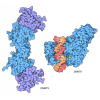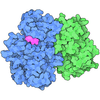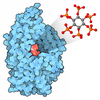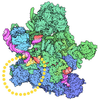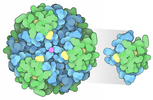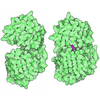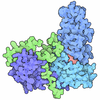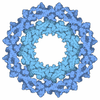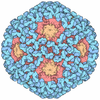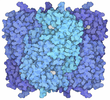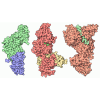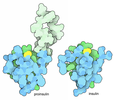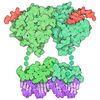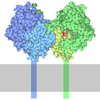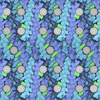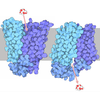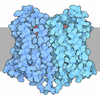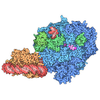登録情報 データベース : PDB / ID : 7ao8タイトル Structure of the MTA1/HDAC1/MBD2 NURD deacetylase complex Histone deacetylase 1 Metastasis-associated protein MTA1 Methyl-CpG-binding domain protein 2 キーワード / / 機能・相同性 分子機能 ドメイン・相同性 構成要素
/ / / / / / / / / / / / / / / / / / / / / / / / / / / / / / / / / / / / / / / / / / / / / / / / / / / / / / / / / / / / / / / / / / / / / / / / / / / / / / / / / / / / / / / / / / / / / / / / / / / / / / / / / / / / / / / / / / / / / / / / / / / / / / / / / / / / / / / / / / / / / / / / / / / / / / / / / / / / / 生物種 Homo sapiens (ヒト)手法 / / / 解像度 : 4.5 Å データ登録者 Millard, C.J. / Fairall, L. / Ragan, T.J. / Savva, C.G. / Schwabe, J.W.R. 資金援助 組織 認可番号 国 Wellcome Trust WT100237/Z/12/Z Medical Research Council (MRC, United Kingdom) MC_PC_17136 Wolfson Foundation
ジャーナル : Nucleic Acids Res / 年 : 2020タイトル : The topology of chromatin-binding domains in the NuRD deacetylase complex.著者 : Christopher J Millard / Louise Fairall / Timothy J Ragan / Christos G Savva / John W R Schwabe / 要旨 : Class I histone deacetylase complexes play essential roles in many nuclear processes. Whilst they contain a common catalytic subunit, they have diverse modes of action determined by associated ... Class I histone deacetylase complexes play essential roles in many nuclear processes. Whilst they contain a common catalytic subunit, they have diverse modes of action determined by associated factors in the distinct complexes. The deacetylase module from the NuRD complex contains three protein domains that control the recruitment of chromatin to the deacetylase enzyme, HDAC1/2. Using biochemical approaches and cryo-electron microscopy, we have determined how three chromatin-binding domains (MTA1-BAH, MBD2/3 and RBBP4/7) are assembled in relation to the core complex so as to facilitate interaction of the complex with the genome. We observe a striking arrangement of the BAH domains suggesting a potential mechanism for binding to di-nucleosomes. We also find that the WD40 domains from RBBP4 are linked to the core with surprising flexibility that is likely important for chromatin engagement. A single MBD2 protein binds asymmetrically to the dimerisation interface of the complex. This symmetry mismatch explains the stoichiometry of the complex. Finally, our structures suggest how the holo-NuRD might assemble on a di-nucleosome substrate. 履歴 登録 2020年10月14日 登録サイト / 処理サイト 改定 1.0 2020年11月11日 Provider / タイプ 改定 1.1 2020年12月30日 Group / カテゴリ / citation_authorItem _citation.country / _citation.journal_abbrev ... _citation.country / _citation.journal_abbrev / _citation.journal_id_ASTM / _citation.journal_id_CSD / _citation.journal_id_ISSN / _citation.journal_volume / _citation.page_first / _citation.page_last / _citation.pdbx_database_id_DOI / _citation.pdbx_database_id_PubMed / _citation.title / _citation.year / _citation_author.identifier_ORCID 改定 1.2 2024年5月1日 Group / Database references / Refinement descriptionカテゴリ chem_comp_atom / chem_comp_bond ... chem_comp_atom / chem_comp_bond / database_2 / em_3d_fitting_list / pdbx_initial_refinement_model Item _database_2.pdbx_DOI / _database_2.pdbx_database_accession ... _database_2.pdbx_DOI / _database_2.pdbx_database_accession / _em_3d_fitting_list.accession_code / _em_3d_fitting_list.initial_refinement_model_id / _em_3d_fitting_list.source_name / _em_3d_fitting_list.type
すべて表示 表示を減らす
 データを開く
データを開く 基本情報
基本情報 要素
要素 キーワード
キーワード 機能・相同性情報
機能・相同性情報 Homo sapiens (ヒト)
Homo sapiens (ヒト) データ登録者
データ登録者 英国, 3件
英国, 3件  引用
引用 ジャーナル: Nucleic Acids Res / 年: 2020
ジャーナル: Nucleic Acids Res / 年: 2020
 構造の表示
構造の表示 ムービービューア
ムービービューア Molmil
Molmil Jmol/JSmol
Jmol/JSmol ダウンロードとリンク
ダウンロードとリンク ダウンロード
ダウンロード 7ao8.cif.gz
7ao8.cif.gz PDBx/mmCIF形式
PDBx/mmCIF形式 pdb7ao8.ent.gz
pdb7ao8.ent.gz PDB形式
PDB形式 7ao8.json.gz
7ao8.json.gz PDBx/mmJSON形式
PDBx/mmJSON形式 その他のダウンロード
その他のダウンロード 7ao8_validation.pdf.gz
7ao8_validation.pdf.gz wwPDB検証レポート
wwPDB検証レポート 7ao8_full_validation.pdf.gz
7ao8_full_validation.pdf.gz 7ao8_validation.xml.gz
7ao8_validation.xml.gz 7ao8_validation.cif.gz
7ao8_validation.cif.gz https://data.pdbj.org/pub/pdb/validation_reports/ao/7ao8
https://data.pdbj.org/pub/pdb/validation_reports/ao/7ao8 ftp://data.pdbj.org/pub/pdb/validation_reports/ao/7ao8
ftp://data.pdbj.org/pub/pdb/validation_reports/ao/7ao8 リンク
リンク 集合体
集合体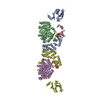
 要素
要素 Homo sapiens (ヒト) / 遺伝子: MBD2 / 発現宿主:
Homo sapiens (ヒト) / 遺伝子: MBD2 / 発現宿主:  Homo sapiens (ヒト) / 参照: UniProt: Q9UBB5
Homo sapiens (ヒト) / 参照: UniProt: Q9UBB5 Homo sapiens (ヒト) / 遺伝子: MTA1 / Cell (発現宿主): HEK293 / 発現宿主:
Homo sapiens (ヒト) / 遺伝子: MTA1 / Cell (発現宿主): HEK293 / 発現宿主:  Homo sapiens (ヒト) / 参照: UniProt: Q13330
Homo sapiens (ヒト) / 参照: UniProt: Q13330 Homo sapiens (ヒト) / 遺伝子: HDAC1, RPD3L1 / Cell (発現宿主): HEK293 / 発現宿主:
Homo sapiens (ヒト) / 遺伝子: HDAC1, RPD3L1 / Cell (発現宿主): HEK293 / 発現宿主:  Homo sapiens (ヒト) / 参照: UniProt: Q13547, histone deacetylase
Homo sapiens (ヒト) / 参照: UniProt: Q13547, histone deacetylase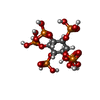




 試料調製
試料調製 Homo sapiens (ヒト)
Homo sapiens (ヒト) Homo sapiens (ヒト)
Homo sapiens (ヒト) 電子顕微鏡撮影
電子顕微鏡撮影
 FIELD EMISSION GUN / 加速電圧: 300 kV / 照射モード: FLOOD BEAM
FIELD EMISSION GUN / 加速電圧: 300 kV / 照射モード: FLOOD BEAM 解析
解析 ムービー
ムービー コントローラー
コントローラー



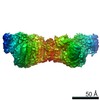


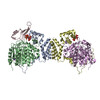




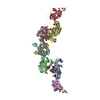


 PDBj
PDBj
